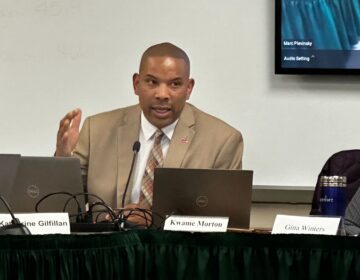Group may head back to court over lack of N.J. school desegregation
A lawsuit filed last year claims residency rules are to blame for lack of diversity in New Jersey public education.

Students in the 3rd grade at St. Paul School in Princeton, N.J. are pictured in this file photo (Tom Mihalek/AP Images for Skype)
This story originally appeared on NJ Spotlight.
—
A coalition of organizations that sued New Jersey last year to desegregate public schools is prepared to go back to court to press for a solution, because of a lack of progress in settlement talks with state officials.
That was the message delivered Tuesday by former New Jersey Supreme Court Justice Gary Stein to a special Joint Committee on the Public Schools hearing on education access and equity in Trenton. Stein chairs the New Jersey Coalition for Diverse and Inclusive Schools that coordinated the lawsuit filed last May alleging the state’s public school residency rules are unconstitutional because they have led to a high level of school segregation by forcing most children to attend classes where they live.
“After we filed our lawsuit in May, the state invited us to begin discussions that might lead to a settlement of the litigation,” Stein said. The coalition’s experts have been meeting with representatives of the state Department of Education, the Attorney General and Gov. Phil Murphy since last September. While there have been “cordial meetings, cooperative meetings,” these have not produced an agreement, Stein said.
“I fear that we’ve come to the conclusion that in order to achieve the results that are necessary for the children in New Jersey who attend segregated schools, we may have to return to court,” Stein added.
There had been hope that the state would settle the case, particularly after Murphy spokesman Dan Bryan, on the day the suit was filed, said the governor “believes strongly that we must combat the deeply rooted problem of segregation” and was “deeply committed to boosting diversity in our schools.”
Yesterday, Bryan referred questions about the suit to the Attorney General’s office, which does not comment on pending litigation.
“Rather than take an adversarial stand, the governor should acknowledge the grave constitutional violations occurring in New Jersey schools and lead the effort to sit down with the plaintiffs and work out a plan to begin the process of integrating our schools,” said Carolyn Chang, immediate past president of the Association of Black Women Lawyers of New Jersey. “The children of New Jersey, my children, other children in East Orange and Essex County and other parts of the state have waited long enough. Now is the time for the grown-ups in the state to act and resolve one of the central civil rights challenges of our time.”
Stein said there is an urgency to eliminating school segregation because “we have hundreds of thousands of children who deserve a better opportunity to get an education than they are currently receiving.”
Data underscores segregation
The state’s schools are among the six most racially segregated in the nation, more so than all the states in the former Confederacy, said Elise Boddie, a law professor and founder and executive director of The Inclusion Project at Rutgers University Law School in Newark. Nearly half of black and Hispanic students — some 270,000 pupils — attend schools where at least 90 percent of those enrolled are students of color. Eight of 10 black and Latino students in racially segregated schools come from low-income families, according to the coalition.
School segregation is an inevitable result when most students attend the public schools where they live and statistics show that New Jersey is among the most segregated states in the nation. Much of the northwestern suburbs and Monmouth, Ocean and Burlington counties have populations that are at least 80 percent non-Hispanic white, while Newark and its environs, as well as smaller cities around the state, are more than 80 percent black and Latino.
Boddie said New Jersey’s segregation is “more subtle” than that of the South in the 1950s, when the law required black children to attend separate schools than those where white children were educated.
“The problem with segregation is that it makes us more likely to assume that people are a certain way — to stereotype how they think and who they are,” Boddie said. “With segregation you often don’t get a chance to know someone from a different racial background. So you never get to learn why all those things you think you know are actually wrong.”
Connie Pascale, a lawyer who was vice-president of Legal Services of New Jersey, said there is one major reason for the continuing segregation in the state.
“Racism is at the heart of this problem and it persists to this day in many forms,” he said, adding that racism is behind why many people in predominantly white suburbs continue to try to stop the construction of affordable housing within their borders.
Lawmaker: ‘We will find out what’s going on here’
Assemblywoman Mila Jasey (D-Essex), co-chair of the joint committee, said she has been concerned with the problem and called for at least two hearings — yesterday’s was the first — to examine the issue and begin to explore ways to integrate schools. Next month, the committee is set to hear from superintendents.
“Our purpose today was not so much to find solutions, but to set the table,” said Jasey, who called the statistics and testimony given during the two-hour hearing about the extent and effects of segregation “sobering.”
She said she thinks Murphy would be willing to consider implementing changes to begin integrating schools and said she would seek to discuss the issue and the pending litigation.
“We will find out what’s going on there,” Jasey said.
Sen. Ron Rice (D-Essex), the other co-chair of the committee, said he is “very much concerned” that the settlement talks may have come up empty and also vowed to contact Murphy’s office about the lawsuit. He said he is anxious to work on solving the problem of segregation.
“We can find ways to do anything we want to do to benefit the people,” said Rice, who also chairs the New Jersey Legislative Black Caucus. He acknowledged, though, that some solutions — particularly if they involve busing students to achieve racial and ethnic balance — may be costly.
Among the solutions offered by Stein are expanding school choice using magnet schools and other methods that cross district boundary lines, changing the admission policies of the highly competitive vocational academies to foster integration, and moving to countywide schools.
Narrowing the achievement gap
Boddie said there are many benefits to integrating schools. For example, research shows that desegregation can narrow the achievement gap between white students and black and Latinos.
In New Jersey, that gap is wide. Of students at all grade levels taking the PARCC English Language Arts Literacy tests in 2017-2018, 65.6 percent of whites scored essentially a passing grade, compared with 42.5 percent of Hispanics and 37.3 percent of blacks. And on math tests in grades 3 through 8, as well as geometry and algebra I and II, the passing rate for white students was 54.1 percent, compared to 29.2 percent for Latinos and 23.4 percent for blacks.
“We also know that integration leads to higher graduation rates and that students who attend integrated schools are more likely to go to college,” Boddie continued. “It leads to higher levels of employment and higher incomes and better health outcomes. We know that diversity makes us smarter. It improves our cognitive and problem-solving skills … We also know that integration builds empathy and reduces bias and helps students learn to question stereotypes.”
It is not enough to simply improve the schools that are majority non-white, the advocates say. New Jersey has battled for decades in the courts over how it funds public schools and has implemented a formula that is meant to ensure that even students in the poorest districts, which are often minority-majority, receive the “thorough and efficient” education guaranteed by the state constitution. But the School Finance Reform Act that is supposed to do that remains years away from being fully funded.
“Separate will never be equal because when you segregate people — as we do when we rely on residential borders to decide where a child goes to school — you draw a fence around them,” Boddie said. “You isolate them from power, from resources, from wealth. Segregation separates people from opportunity. When you draw that line around people, you dehumanize them. You treat them as if they are a threat. It is easier to dismiss people, to dismiss their struggles, to treat them like they don’t matter if they are ‘over there.’”
Stein said implementing integration is going to be controversial, complicated and difficult.
“Our entire Legislature will need to show courage and foresight,” he said. “I deeply believe it is our collective duty to fix it, no matter how hard that may be.”
WHYY is your source for fact-based, in-depth journalism and information. As a nonprofit organization, we rely on financial support from readers like you. Please give today.




